Whether you’re searching for a few American chicken breeds for your backyard, these 11 classic American chicken breeds are examples of U.S. heritage and unique characteristics.
All breeds were created from colonial-era times to the early 20th century and have been bred for dual-purpose (eggs and meat) and to adapt to American farms.
Each section below contains a brief history of the breed, which emphasizes its U.S. background, followed by quick facts like origin, appearance, egg count, etc.
1. Plymouth Rock
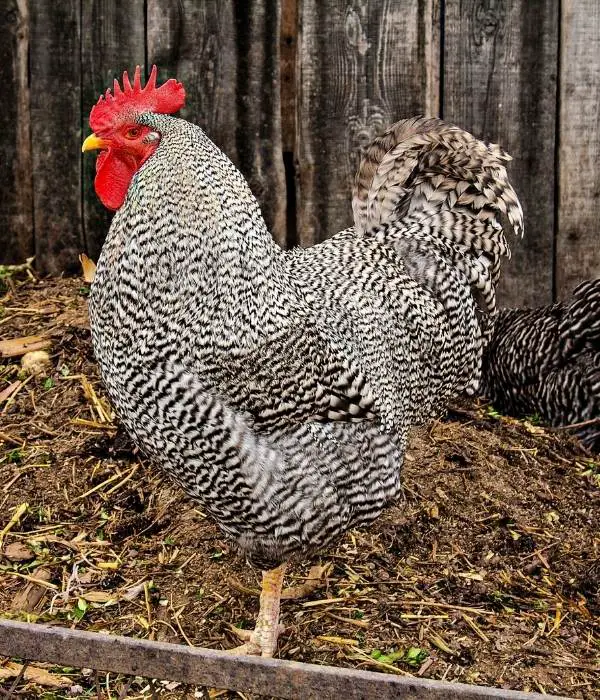
Developed in Massachusetts in the mid-1800s, the Plymouth Rock, also called Barred Rock, became one of the most iconic American chicken breeds for dual-purpose use.
Shown in 1849, it quickly earned nicknames like “America’s favorite breed” and “the Hereford of the poultry world,” reflecting its ubiquity on U.S. farms. Bred from Dominique and Black Java, this heritage chicken breed was prized for both brown eggs and meat.
By the early 20th century the barred variety especially was widespread; today it remains a cold-hardy, classic farm breed in the American Poultry Association’s American class.
- Origin: Massachusetts/New England (mid-1800s)
- Physical Appearance: Traditionally barred black-and-white (several colors recognized), single comb, bright red wattles/earlobes, yellow skin and legs, long broad back
- Egg Production: Good layer (~200–250 large brown eggs per year)
- Meat Quality: Dual-purpose; once a principal broiler/roaster breed
- Breeding: Hardy setter; hens often go broody and raise chicks
- Temperament & Behavior: Very docile, calm and friendly
- Hardiness: Exceptionally cold-hardy; tolerates heat well
- Lifespan: Around 6–8 years
- Best Suited For: Beginners, mixed backyard flocks, free-ranging dual-purpose flocks (eggs and meat)
- Fun Fact/Unique Feature: Nicknamed “Hereford of the poultry world” for its popularity; hens are known to be excellent brooders.
2. Rhode Island Red
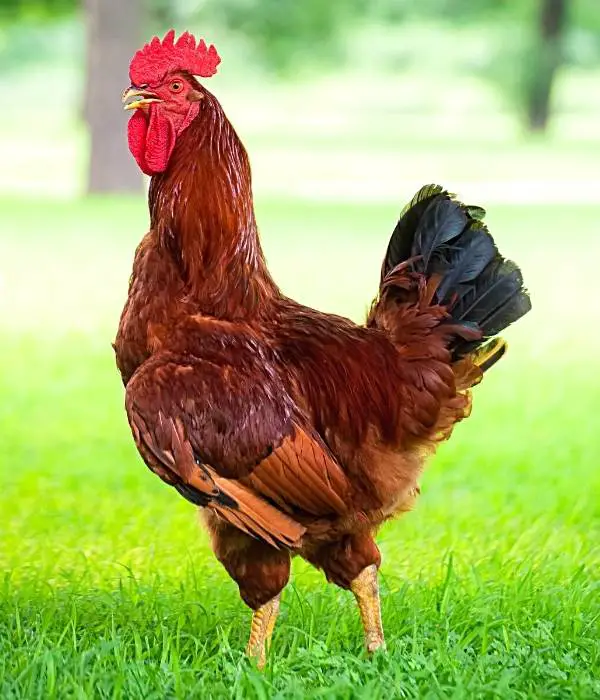
The Rhode Island Red was developed in Rhode Island and Massachusetts in the late 1800s. This deep red chicken originated by crossbreeding Malay, Java, Cochins, and Leghorn.
It was bred as a rugged dual-purpose bird, and by the early 20th century its descendants had been bred into mainly egg-laying lines. RIRs lay large brown eggs and provide rich-flavored meat.
Today the Red is an classic American chicken breed: it’s even the state bird of Rhode Island, and it remains a staple layer in backyards and farms across the U.S.
- Origin: Rhode Island/Massachusetts, late 19th century (breds from Asian and European stock)
- Physical Appearance: Lustrous deep red plumage (hen) to almost black tail (cock); single or rose comb (vivid red), red wattles/earlobes, reddish-bay eyes, yellow legs
- Egg Production: Excellent layers (~200–300 brown eggs per year)
- Meat Quality: Dual-purpose; offers large, rich-flavored carcass
- Breeding: Modern strains bred primarily for egg production; original “old-type” birds still dual-purpose
- Temperament & Behavior: Generally active and hardy; often fairly tame around people (some can be assertive with each other)
- Hardiness: Tough in heat or cold; a very adaptable breed
- Lifespan: Around 5–8 years
- Best Suited For: Egg flocks, homestead or small farm use (and backyard flocks seeking a heritage bird)
- Fun Fact/Unique Feature: Official state bird of Rhode Island; one of the foundation breeds for many modern hybrids.
3. Delaware
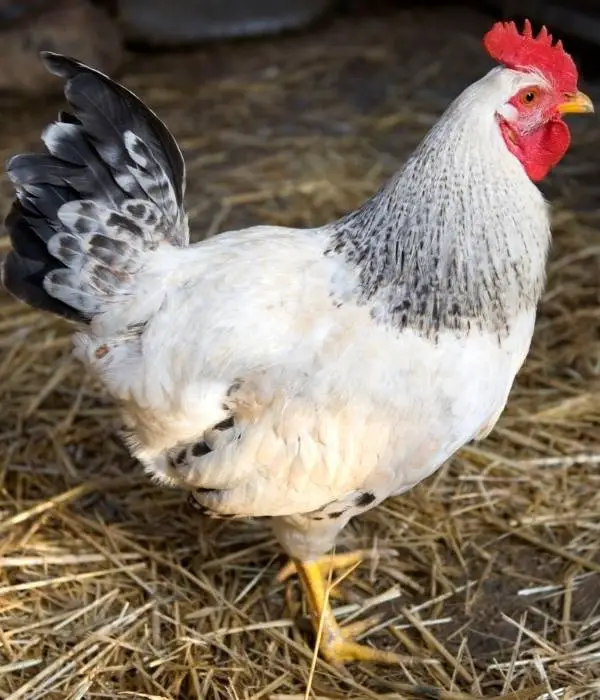
The Delaware was developed in Delaware/Delmarva in the 1940s by George Ellis. Originating as a sport (white chicks) from Barred Plymouth Rock × New Hampshire crosses, it was first called the Indian River chicken.
After selective breeding (circa 1940) it became Delaware’s signature American chicken breed and was widely used by East Coast farmers for market broilers.
Delawares have a striking white body with black barred neck and tail (Barred-Columbian pattern) and lay brown eggs.
Although eventually supplanted by the Cornish-Rock cross, the Delaware was once the principal American poultry breed for broilers and today is a recovering heritage chicken breed.
- Origin: Delaware (Delmarva Peninsula), developed ~1940
- Physical Appearance: White plumage with black barred tail and neck hackles (“Barred Columbian” pattern); single comb and bright red wattles/earlobes; yellow skin
- Egg Production: Good layers of large to jumbo brown eggs (about 180–260 per year)
- Meat Quality: Dual-purpose; once the main broiler bird with excellent meat, producing large carcasses; still a good, lean table bird
- Breeding: Bred for rapid growth; hens are moderately broody/setters (good mothers)
- Temperament & Behavior: Calm and steady; docile (Cackle Hatchery notes them as “docile”)
- Hardiness: Hardy, free-range tolerant (thrives outside); good winter layer
- Lifespan: Around 5–8 years
- Best Suited For: Dual-purpose flocks on small farms; backyard homesteads (especially free-range foragers); sustainable heritage programs
- Fun Fact/Unique Feature: All feather shafts are white, so combined with yellow skin the Delaware has a very clean-looking carcass. (They were named for the state of origin after initial call “Indian River.”)
4. Dominique
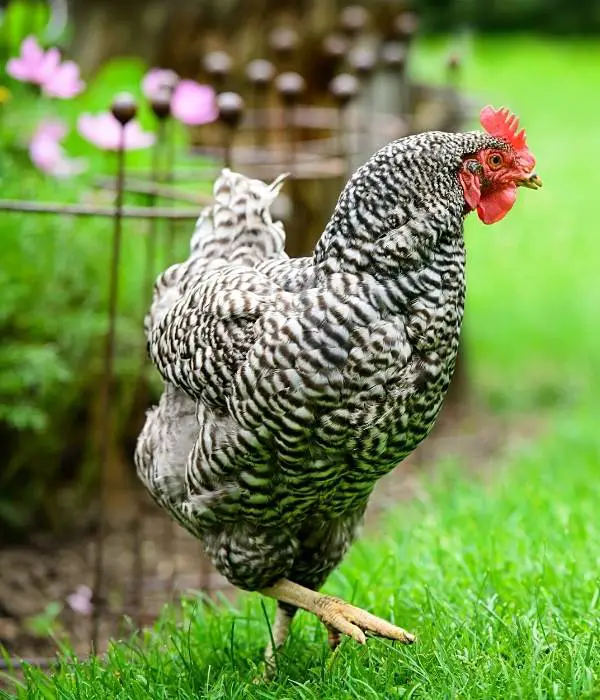
The Dominique is widely considered America’s oldest chicken breed. Its barred plumage and rose comb hint at English ship-born ancestors brought by colonists.
Dominiques were well established in New England by the late 1700s, and they were the first bantams shown at a U.S. poultry exhibition (Boston, 1849).
Long prized as a dual-purpose farm bird, Dominques are cold-hardy, good foragers and traditionally lay brown eggs.
After declining mid-20th century, conservation efforts have revived the Dominique. It remains a living link to American heritage chicken breeds and a useful choice among traditional chickens today.
- Origin: Colonial America (Northeastern U.S.)—present by 1750s
- Physical Appearance: Black-and-white barred (cuckoo pattern) plumage; rose comb; yellow legs and skin
- Egg Production: Reliable layers of brown eggs (roughly 200–275 per year)
- Meat Quality: Dual-purpose; moderate-size bird (4–7+ lbs) with yellow skin, suitable for the table
- Breeding: Hens often go broody and are good setters; traditional breed with solid maternal instincts
- Temperament & Behavior: Calm, friendly and attentive; good-natured underfoot
- Hardiness: Very hardy (tight feathers resist frost); excellent foragers in pasture or range
- Lifespan: Typically 6–8 years
- Best Suited For: Heritage breed fans, free-range/backyard coops, beginners wanting a reliable dual-purpose bird
- Fun Fact/Unique Feature: Known as “Pilgrim Fowl”, the Dominique was the first chicken shown in America (Boston, 1849). Its rose comb made it more frost-resistant than many single-comb breeds.
5. Buckeye
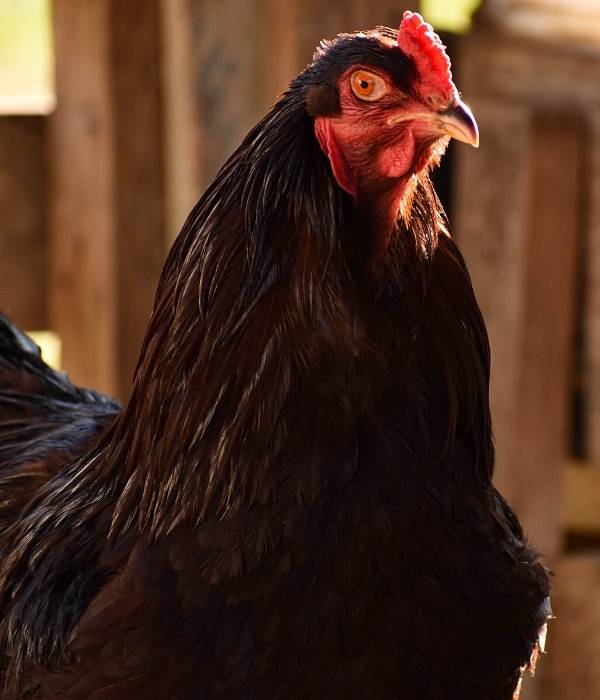
The Buckeye is a rare American chicken breed created in Ohio in 1896 by Nettie Metcalf. Metcalf crossed Barred Plymouth Rocks, Buff Cochins and Black-breasted Red Game to craft a hardy, red bird suited to harsh winters.
Buckeyes were actually developed before Rhode Island Reds. These chickens are named after Ohio’s state tree (the buckeye nut) and are the only recognized U.S. breed created by a woman.
With mahogany-red plumage and a small pea comb, Buckeyes are cold-hardy dual-purpose birds. Though once kept on family farms, they’re now quite rare listed by Livestock Conservancy: “threatened” heritage poultry breed.
- Origin: Ohio (late 19th century, bred by Nettie Metcalf)
- Physical Appearance: Glossy mahogany-brown plumage with black on wings/tail; unique pea comb (only American breed with one) and small wattles; yellow skin and legs
- Egg Production: Good layers of medium–large brown eggs (about 150–200 per year)
- Meat Quality: Dual-purpose; slow-maturing but eventually produce a large, meaty carcass with dark, flavorful meat
- Breeding: Moderate brooding tendency; hens often set on eggs (breeders use them for natural incubation)
- Temperament & Behavior: Friendly and easy-going overall; roosters can be brave (some are very protective), but flocks generally get along well
- Hardiness: Exceptionally cold-hardy (pea comb and small wattles resist frost); also tolerates heat surprisingly well for a cold-weather bird
- Lifespan: Around 6–8 years
- Best Suited For: Homesteaders in cold climates, free-range flocks, anyone wanting a historic dual-purpose bird
- Fun Fact/Unique Feature: Buckeye is the only APA-standard chicken bred solely by a woman. The name and plumage were inspired by Ohio’s buckeye tree and nut.
6. Jersey Giant
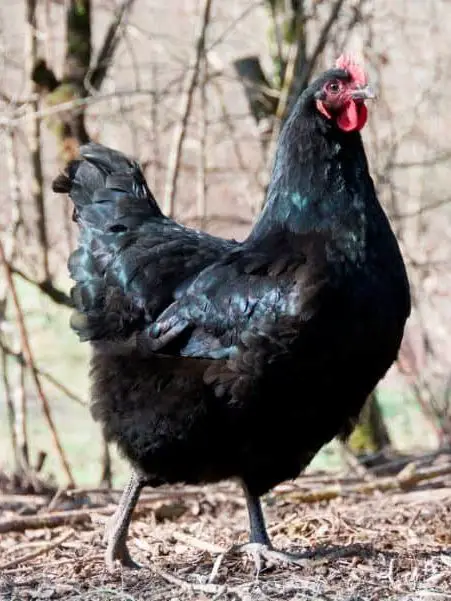
Developed in New Jersey between 1870 and 1890 by the Black brothers, the Jersey Giant was bred to be a premium table bird – even aiming to replace turkeys for meat.
They crossed Black Javas, Langshans and Brahmas to create a massive frame. By 1921 the name “Jersey Giant” was officially adopted, and APA recognized them in 1922.
Today’s Giants are one of the largest chicken breeds (mature roosters 13–15 lbs), with varieties in black, white and blue plumage.
These calm, impressive birds mature relatively slowly but yield huge, fine-grained meat (one bird can feed a family). Hens lay extra-large brown-to-cream eggs (150–200 per year), making them a valuable heritage poultry breed for both meat and eggs.
- Origin: Burlington County, New Jersey (1870s–1890s by John and Thomas Black)
- Physical Appearance: Gigantic body; single comb; legs yellow (black birds have black legs); original black birds have greenish-black sheen. Three color varieties accepted (black, white, blue).
- Egg Production: Good layers for a giant – about 150–200 extra-large eggs per year (cream to dark brown in color)
- Meat Quality: Outstanding table bird; very large carcass (capable of feeding four or more), coarse fine-textured white meat; raised for roasters and capons
- Breeding: Slow to mature (6–9 months to full size); not very heat tolerant (large combs can frostbite in winter)
- Temperament & Behavior: Mellow and calm; good-natured and forgiving (quiet birds overall)
- Hardiness: Cold-hardy (heavy body, but combs need protection); poor in hot climates without shade
- Lifespan: 6–8 years or more
- Best Suited For: Homesteads and farms needing large meat birds; exhibition (they’re popular in poultry shows); a flock protecting garden from predators (their size is intimidating)
- Fun Fact/Unique Feature: Giants were intentionally bred to replace turkeys on the dinner table. At maturity, roosters can reach up to 15 lbs – they truly live up to the “Giant” name.
7. Java
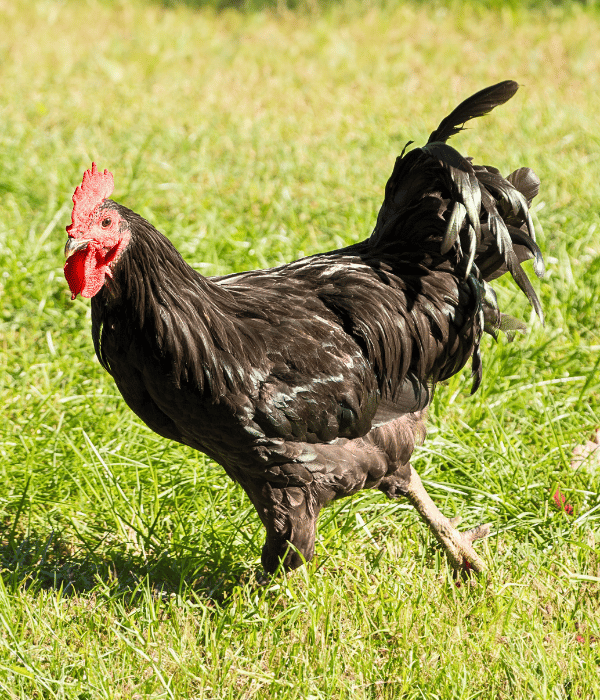
The Java is one of America’s oldest chicken breeds (second only to the Dominique). Developed in New England by the early 19th century (first mention ~1835), its exact Asian origins are unclear.
Javas were the backbone of U.S. farms in the 1800s, valued for both eggs and meat. Today they’re critically endangered but well-regarded as heritage poultry breed in America.
Javas are large, sturdy, heavy birds with a single comb. They come in black, white (once lost), mottled, and rare Auburn. They lay brown eggs and have yellow skin.
Temperament is calm and adaptable, and they’re very cold-hardy. Javas also contributed genetics to many other American chicken breeds (including the Rhode Island Red, Plymouth Rock and Jersey Giant).
- Origin: United States (early 1800s) from mixed unknown Asian stock
- Physical Appearance: Large, heavy-bodied birds (roosters ~9–10 lbs) with a single comb; skin yellow; original varieties black (with green sheen), white, mottled, and the rare Auburn
- Egg Production: Moderate layers of brown eggs (roughly 150–180 per year); foundational in developing American layer breeds
- Meat Quality: Dual-purpose; good meat bird (was a main meat breed in 19th c.)
- Breeding: Once the basis for many American breeds; now breeders focus on preserving pure genetics
- Temperament & Behavior: Docile and hardy; easy keepers that forage well (good foragers on pasture)
- Hardiness: Very hardy and adaptable; tolerates cold weather exceptionally well
- Lifespan: Around 6–8 years
- Best Suited For: Heritage poultry enthusiasts, show flocks, homesteaders; small-scale egg and meat production
- Fun Fact/Unique Feature: The Java’s name is misleading – it isn’t from Java (Indonesia) but was developed in the U.S.. It helped create other famous breeds (Yellow skin gene was passed to Dominiques, and it influenced Rhode Island Reds, Plymouth Rocks, Jersey Giants).
8. Ameraucana
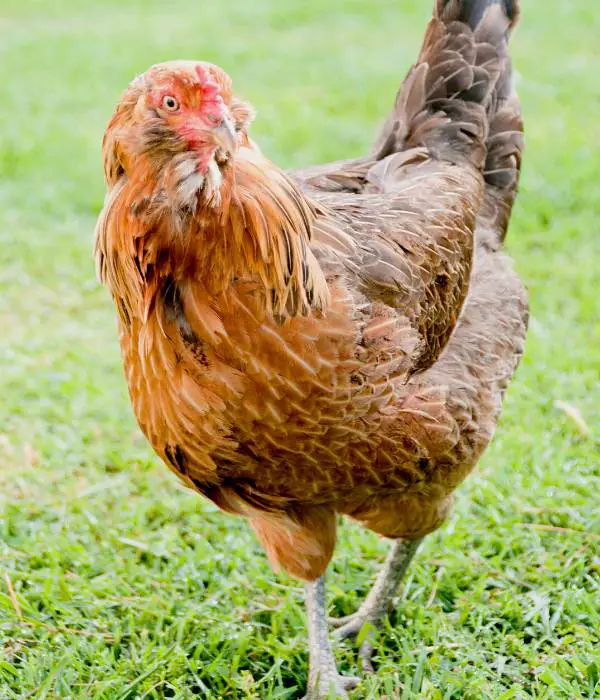
The Ameraucana is an American chicken breed created in the 1970s to preserve the blue-egg gene from Chilean Araucana stock.
It was standardized in the U.S. (American Standard of Perfection) in 1984 as a distinct breed.
Ameraucanas have pea combs and the characteristic “muffs and beard” around the face. They lay blue or green eggs and remain one of the best heritage chicken breeds for colorful egg baskets.
Our flock’s Ameraucanas come in black, blue and splash varieties, each with slate-colored legs. Bred as friendly backyard birds, they are generally docile.
These medium-sized birds produce about 180 or so eggs per year and are useful for both novelty egg color and moderate meat use in homesteads.
- Origin: United States (1970s, from Chilean Araucana chickens)
- Physical Appearance: Small-medium size; pea comb; distinct muffs and beard; slate-gray legs; plumage colors include black, blue, splash, wheaten, etc.
- Egg Production: Lay medium-large eggs in blue to green shades (~150–200 eggs/year)
- Meat Quality: Light to moderate; mostly kept for eggs or ornamental value rather than heavy meat production
- Breeding: Many strains available; hens are generally good mothers and occasionally go broody
- Temperament & Behavior: Mild-mannered and easy to handle
- Hardiness: Hardy (adaptable to cold and heat)
- Lifespan: About 5–7 years
- Best Suited For: Backyard flocks wanting novelty blue eggs and friendly layers; small-scale flocks; heritage chicken breed collections
- Fun Fact/Unique Feature: The Ameraucana carries the blue-egg gene (from the Chilean Araucana) and sports the distinctive beard/muffs and pea comb. The breed was created to avoid the lethal tailed-gene of pure Araucanas but retain blue eggs.
9. Wyandotte
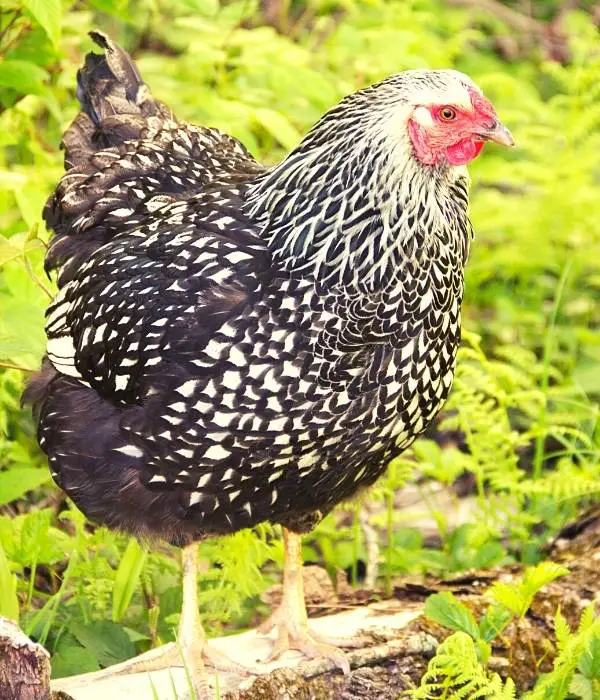
Named after a Native American tribe of New York/Ontario, the Silver Laced Wyandotte was developed in the 1870s–1880s in the U.S..
Originally called the “American Sebright,” it was renamed Wyandotte upon APA recognition in 1883. The classic silver-laced variety (white feathers edged in black) was first, but many colors now exist. Wyandottes have a flat rose comb and a sturdy, rounded body.
They are excellent dual-purpose birds: hens lay brown eggs and some go broody, while roosters and hens reach a good table weight (roosters ~8–9 lbs, hens ~6.5 lbs).
Bred for both look and utility, Wyandottes are friendly, calm, and very cold-hardy, making them one of the most dependable American chicken breeds and a resilient heritage poultry breed.
- Origin: Upstate New York (and Ontario), c. 1870s–1880s
- Physical Appearance: Medium-large bird; rose comb; face/wattles/earlobes bright red. Original Silver-Laced (white with black lacing) was first color; now many (golden-laced, buff, black, etc.) are recognized. Feet yellow.
- Egg Production: Good layers of medium-large light brown eggs (200+ per year in ideal conditions)
- Meat Quality: Dual-purpose; nicely plump frame with good breast meat (hens ~6.5 lbs)
- Breeding: Mature relatively quickly; hens often set on their eggs (decent broodiness)
- Temperament & Behavior: Friendly and calm; well-suited to family flocks
- Hardiness: Cold-hardy (tolerates winter well)
- Lifespan: Around 6–8 years
- Best Suited For: Backyard/heritage flocks; families (they’re gentle) and homesteaders wanting a versatile show-quality bird
- Fun Fact/Unique Feature: The breed was originally named “American Sebright” but renamed for the Wyandot tribe. Their rose comb and laced plumage make them very distinctive among Americans. The Livestock Conservancy notes Wyandotte as “graduated” from endangered status (healthy population).
10. New Hampshire Red
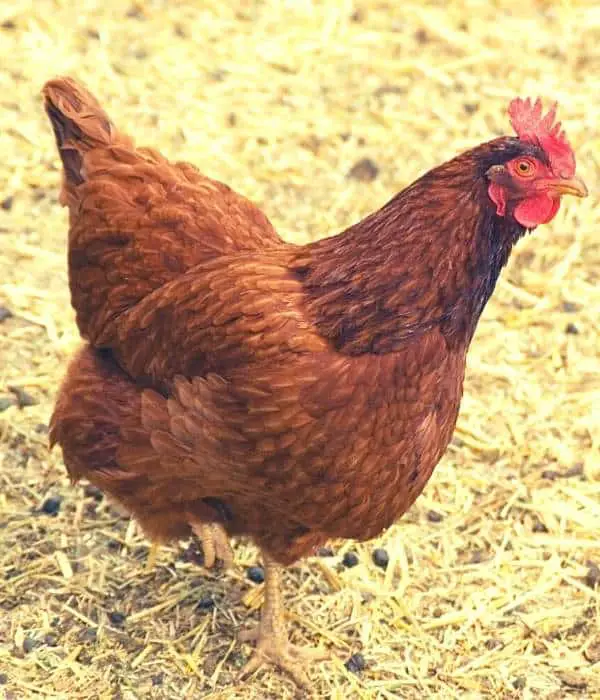
The New Hampshire Red was developed in New Hampshire in the early 1900s by selectively breeding Rhode Island Reds for rapid feathering and growth.
No other breeds were used – just stock of Rhode Island Reds bred for early maturity and meat yield. The resulting bird is a lighter chestnut-red than the classic RIR and grows very quickly into a meaty carcass.
It was admitted to the APA Standard in 1935. New Hampshires lay brown eggs (~220/year) and, like their RIR parents, are good dual-purpose birds. They were even designated the official poultry of the state of New Hampshire in 2018.
- Origin: New Hampshire (developed 1900s from Rhode Island Red stock)
- Physical Appearance: Rich golden-bay to chestnut-red plumage; tail feathers have black tips (cock); single five-pointed comb; yellow legs
- Egg Production: Good layers (~220 medium-large brown eggs per year)
- Meat Quality: Dual-purpose; fast-growing and yields a heavy, well-flavored carcass (bred for meat emphasis)
- Breeding: Hens reach maturity quickly; can be prone to broodiness (good mothers)
- Temperament & Behavior: Generally calm and friendly (often described as milder than Rhode Island Reds)
- Hardiness: Hardy breed (handles cold well)
- Lifespan: Around 6–8 years
- Best Suited For: Meat-focused family flocks; homesteads wanting a quick-maturing heritage bird
- Fun Fact/Unique Feature: Designated the official poultry of New Hampshire in 2018 (after a campaign by local schoolchildren).
11. Lamona
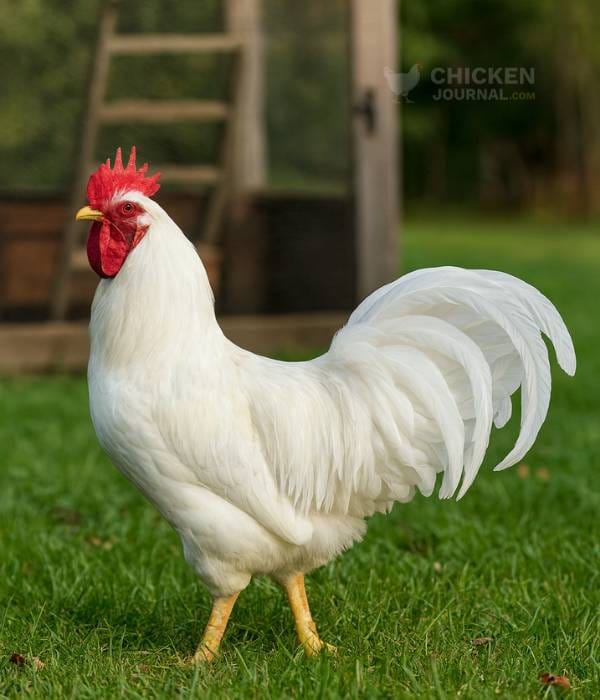
The Lamona is a nearly-forgotten American chicken breed created around 1912–1933 by Harry Lamon at the USDA Beltsville (MD) station.
Lamon wanted the perfect utility bird: white feathers and yellow skin for clean carcass, high egg output, and enough meat yield. He crossed Dorkings hens, White Plymouth Rocks and Leghorns to achieve this.
In 1933 the Lamona was admitted to the Standard of Perfection. It is pure white-feathered with a single comb and uniquely has red earlobes but lays white eggs.
Lamonas weigh about 6–8 lbs. They lay about 4–5 medium large white eggs per week in their first year.
- Origin: Maryland (Beltsville, USDA experiment station), developed 1912–1933 by Harry Lamon
- Physical Appearance: Medium-large, pure white plumage; single comb; yellow skin; red earlobes (unusual trait)
- Egg Production: Lay medium-large white eggs (roughly 180 eggs per year)
- Meat Quality: Dual-purpose; birds around 6–8 lbs with good meat yield (bred for dinner table after laying year)
- Breeding: Some broody tendency; hens make good sitters (used to set other eggs)
- Temperament & Behavior: Friendly, calm and easy to handle; good in confinement or pasture
- Hardiness: Well-feathered; small comb/wattles reduce frostbite in winter; tolerates cold well
- Lifespan: Around 5–8 years
- Best Suited For: Heritage enthusiasts, dual-purpose flocks seeking white eggs and meat; backyard flocks wanting a docile bird
- Fun Fact/Unique Feature: Lamonas are unusual in having red earlobes and laying white eggs (most red-eared birds lay brown eggs). Also, their white feathers and yellow skin were bred to create a very clean, attractive carcass for American consumers.
Classic American chicken breeds offer an overwhelmingly rich farming tradition in the United States. You’ll find hardy, dual-purpose birds like the Plymouth Rock, Rhode Island Red, Delaware, and Wyandotte that provided sustenance to homesteads for generations.
These heritage poultry breeds deliver reliable brown eggs (and even blue eggs) with delicious meat, paired with approachable temperaments that make them easy for families — even young children — to keep as a flock.
Bred on traditional farms, these chickens were developed to handle varied American climates, thriving through cold winters, hot summers, and free-range conditions.
Each American chicken breed carries its own story: the Dominique reflects colonial roots, the Jersey Giant was bred to replace turkeys at the table, and the Buckeye stands out as the only U.S. breed created by a woman.
Today, you can raise these heritage chicken breeds not only for eggs and meat but also to preserve American agricultural history. When you choose classic American chickens, you support sustainability, reliability, and tradition — keeping alive the legacy of traditional chickens in your backyard or homestead.
